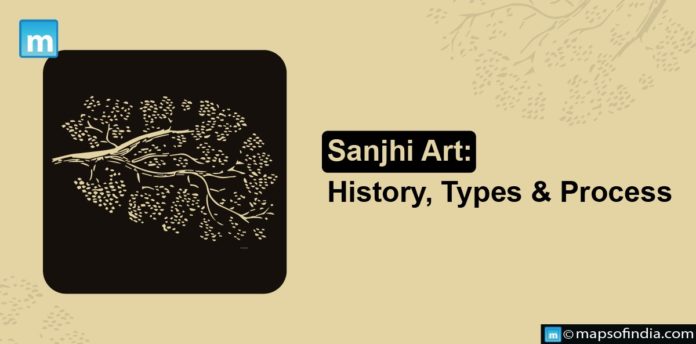Sanjhi Art is a traditional paper-cutting technique that started in Mathura, India. It is well-known for its elaborate designs and fine craftsmanship. Sanjhi art is commonly utilized to create religious and mythological scenes, but it can also be used to create modern designs.
History
Sanjhi art is a traditional paper-cutting technique that started in Mathura, India. It is well-known for its elaborate designs and fine craftsmanship. Sanjhi art is commonly utilized to create religious and mythological scenes, but it can also be used to create modern designs. Sanjhi art dates back to the 16th century when it was employed to embellish Mathura temples. Sanjhi art was very famous during the time of Emperor Akbar, who was an arts patron. Sanjhi art began to fade in prominence during the 18th and 19th centuries. Part of this was due to British colonial control, which stifled Indian culture and traditions. However, Sanjhi art saw a rebirth in the early twentieth century.20th century, thanks to the efforts of artists and patrons such as Maharaja Krishna Dev Pal Singh of Kishangarh.
Types
Sanjhi art is classified into two types:
- Religious and mythological scenes are depicted in traditional Sanjhi art. Lord Krishna and Radha, the Hindu god and goddess of love, are the most popular topics of traditional Sanjhi art.
- Contemporary Sanjhi art covers various subjects, such as landscapes, animals, and people. Contemporary Sanjhi painters frequently experiment with new techniques and materials to create unique art pieces.
Process
Sanjhi art is created with various materials, such as paper, scissors, and glue. Making Sanjhi art is a time-consuming and intricate procedure. A single Sanjhi artwork can take several days to complete. The first step in creating Sanjhi art is to design it. On a piece of paper, the artist will sketch the design. When the design is finished, the artist will use scissors to cut out the various shapes of the pattern. The artwork will now be assembled. The artist will glue the design’s many forms to create a three-dimensional artwork. Other embellishments, such as paint or glitter, may be added to the artwork by the artist.
Famous Sanjhi artists
- Hema Malini: She is a well-known Indian actress and politician. She is also an accomplished Sanjhi artist. Malini is the creator of several Sanjhi artworks, including a portrait of Prime Minister Narendra Modi.
- Gopal Lal Sharma: Gopal Lal Sharma is a Mathura-based Sanjhi artist. For almost 40 years, he has been creating Sanjhi art. Sharma’s Sanjhi artworks have been shown both in India and beyond.
- Sunita Devi: Sunita Devi is a Mathura-based Sanjhi artist. Her elaborate and delicate Sanjhi designs are well-known. Devi’s Sanjhi artworks have appeared in several publications and newspapers.
Sanjhi art is still done in Mathura and other regions of India today. Sanjhi artists continue to develop traditional and contemporary works. Sanjhi art is also being taught in schools and institutions, which is helping to ensure that this traditional art form is passed down to future generations.




